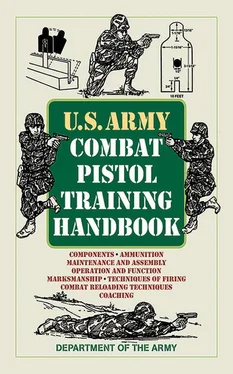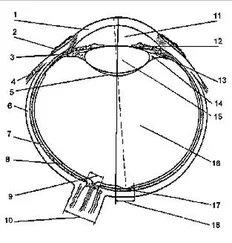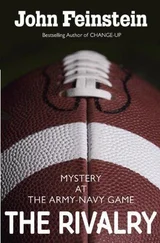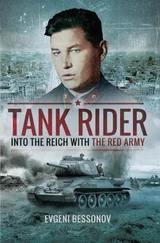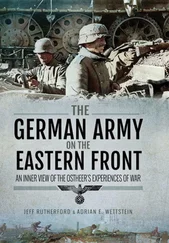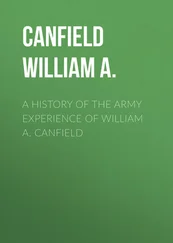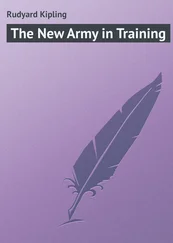c. Scanning. This is the short, abrupt, irregular movement of the firer’s eyes around an object or area every 4 to 10 seconds. With artificial illumination, the firer uses night-fire techniques to engage targets, since targets seem to shift without moving.
NOTE:For more detailed information on the three principles of night vision, see FM 21-75 (US Army Field Manual 21-75).
2-12. Chemical, Biological, Radiological, or Nuclear
When firing a pistol under CBRN conditions, the firer should use optical inserts, if applicable. Firing in MOPP levels 1 through 3 should not be a problem for the firer. Unlike with a rifle, the firer acquires a sight picture with a pistol the same with or without a protective mask. MOPP4 is the only level that might present a problem for a firer, because that level requires him to wear gloves. Gloves could force him to adjust for proper grip and trigger squeeze. Firers should practice firing in MOPP4 to become proficient in CBRN firing.
SECTION III. COACHING AND TRAINING AIDS
Throughout preparatory marksmanship training, the coach-and-pupil method of training should be used. The proficiency of a pupil depends on how well the coach performs his duties. This section provides detailed information on coaching techniques and training aids for pistol marksmanship.
The coach assists the firer by correcting errors, ensuring he takes proper firing positions, and ensuring he observes all safety precautions. The criteria for selecting coaches are a command responsibility. Coaches must have more experience in pistol marksmanship than the student firer. Duties of the coach during instructional practice and record fire include the following:
a. Checking that the:
• Weapon is clear.
• Ammunition is clean.
• Magazines are clean and operational.
b. Observing the firer to see that he:
• Takes the correct firing position.
• Loads the weapon properly and only on command.
• Takes up the trigger slack correctly.
• Squeezes the trigger correctly.
• Calls the shot each time he fires, except during quick fire and rapid fire.
• Holds his breath correctly.
• When he does not fire for 5 or 6 seconds, lowers the weapon and rests his arm.
c. Having the firer breathe deeply several times to relax if he is tense.
2-14. Ball-and-Dummy Method
In this method, the coach loads the weapon for the firer. He may hand the firer a loaded weapon or an empty one. When firing the empty weapon, the firer observes that in anticipating recoil he is forcing the weapon downward as the hammer falls. Repetition of the ball-and-dummy method helps reduce recoil anticipation.
To call the shot is to state where the bullet should strike the target according to the sight picture at the instant the weapon fires, for example, “High,” “a little low,” “to the left,” or “bull’s eye.” Another method of calling the shot is the clock system, for example, “three-ring hit at 8 o’clock” or “four-ring hit at 5 o’clock.” Another method is to place a firing center beside the firer on the firing line. As soon as the shot is fired, the firer must place a finger on the target face or center where he expects the round to hit on the target. This method avoids guessing and computing for the firer. The immediate placing of the finger on the target face gives an accurate call. If the firer calls his shot incorrectly in range fire, he is failing to concentrate on sight alignment and trigger squeeze. Thus, as the weapon fires, he does not know what his sight picture is.
The slow-fire exercise is one of the most important exercises for both amateur and competitive marksmen. Coaches should ensure firers practice this exercise as much as possible. This is a dry-fire exercise.
a. To perform the slow-fire exercise, the firer assumes the standing position with the weapon pointed at the target. The firer should begin by using the two-hand grip, progressing to the one-hand grip as his skill increases. He takes in a normal breath and lets out part of it, locking the remainder in his lungs by closing his throat. He then relaxes, aims at the target, and takes the correct sight alignment and sight picture. He takes up the trigger slack and squeezes the trigger straight to the rear with steady, increasing pressure until the hammer falls, simulating firing.
b. If the firer does not cause the hammer to fall in 5 or 6 seconds, he should return to the pistol-ready position and rest his arm and hand. He then starts the procedure again. The action sequence that makes up this process can be summed up by the key word BRASS. It is a word the firer should think of each time he fires his weapon.
BreatheTake a normal breath, let part of it out, and lock the remainder in the lungs by closing the throat.
RelaxRelax the body muscles.
AimTake correct sight alignment and sight picture, and focus the eye at the top of the front sight.
SlackTake up the trigger slack.
SqueezeSqueeze the trigger straight to the rear with steadily increasing pressure without disturbing sight alignment until the hammer falls.
c. Coaches should observe the front sight for erratic movements during the application of trigger squeeze. Proper application of trigger squeeze allows the hammer to fall without the front sight moving. A small bouncing movement of the front sight is acceptable. Firers should call the shot by the direction of movement of the front sight (high, low, left, or right).
2-17. Air-Operated Pistol, .177 MM
The air-operated pistol is used as a training device to teach the soldier the method of quick fire, to increase confidence in his ability, and to afford him more practice firing. A range can be set up almost anywhere with a minimum of effort and coordination, which is ideal for USAR and NG. If conducted on a standard range, live firing of pistols can be conducted along with the firing of the .177-mm air-operated pistol. Due to light recoil and little noise of the pistol, the soldier can concentrate on fundamentals. This helps build confidence because the soldier can hit a target faster and more accurately. The air-operated pistol should receive the same respect as any firearm. A thorough explanation of the weapon and a safety briefing are given to each soldier.
2-18. Quick-Fire Target Training Device
The QTTD (Figures 2-25 and 2-26) is used with the .177-mm air-operated pistol.
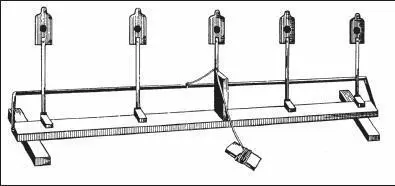
Figure 2-25. The quick-fire target training device.
a. Phase I. From 10 feet, five shots at a 20-foot miniature E-type silhouette. After firing each shot, the firer and coach discuss the results and make corrections.
b. Phase II. From 15 feet, five shots at a 20-foot miniature E-type silhouette. The same instructions apply to this exercise as for Phase I.
c. Phase III. From 20 feet, five shots at a 20-foot miniature E-type silhouette. The same instructions apply to this exercise as for Phases I and II.
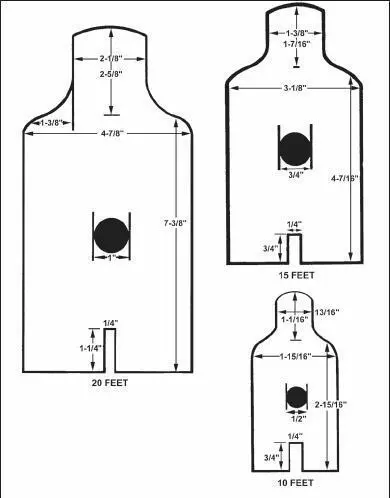
Figure 2-26. Dimensions for the QTTD.
d. Phase IV. From 15 feet, six shots at two 20-foot miniature E-type silhouettes. This exercise is conducted the same as the previous one, except that the firer is introduced to fire distribution. The targets on the QTTD are held in the up position so they cannot be knocked down when hit.
Читать дальше
